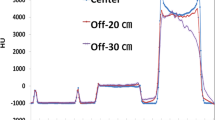Abstract
The purpose of this study was to estimate dose reduction after implementation of asymmetrical cone beam processing using exposure differences measured in a water phantom and a small cohort of clinical coronary CTA patients. Two separate 320 × 0.5 mm detector row scans of a water phantom used identical cardiac acquisition parameters before and after software modifications from symmetric to asymmetric cone beam acquisition and processing. Exposure was measured at the phantom surface with Optically Stimulated Luminescence (OSL) dosimeters at 12 equally spaced angular locations. Mean HU and standard deviation (SD) for both approaches were compared using ROI measurements obtained at the center plus four peripheral locations in the water phantom. To assess image quality, mean HU and standard deviation (SD) for both approaches were compared using ROI measurements obtained at five points within the water phantom. Retrospective evaluation of 64 patients (37 symmetric; 27 asymmetric acquisition) included clinical data, scanning parameters, quantitative plus qualitative image assessment, and estimated radiation dose. In the water phantom, the asymmetric cone beam processing reduces exposure by approximately 20% with no change in image quality. The clinical coronary CTA patient groups had comparable demographics. The estimated dose reduction after implementation of the asymmetric approach was roughly 24% with no significant difference between the symmetric and asymmetric approach with respect to objective measures of image quality or subjective assessment using a four point scale. When compared to a symmetric approach, the decreased exposure, subsequent lower patient radiation dose, and similar image quality from asymmetric cone beam processing supports its routine clinical use.






Similar content being viewed by others
References
Rybicki FJ, Otero HJ, Steigner ML et al (2008) Initial evaluation of coronary images from 320-detector row computed tomography. Int J Cardiovasc Imaging 24:535–546
Steigner ML, Otero HJ, Cai T et al (2009) Narrowing the phase window width in prospectively ECG-gated single heart beat 320-detector row coronary CT angiography. Int J Cardiovasc Imaging 25:85–90
Shrimpton PC, Hillier MC, Lewis MA et al (2006) National survey of doses from CT in the UK: 2003. Br J Radiol 79:968–980
Tuy HK (1983) An inversion formula for cone-beam reconstruction. Siam J Appl Math 43:546–552
Torres FS, Crean AM, Nguyen ET, et al (2010) Strategies for radiation-dose reduction and image-quality optimization in multidetector computed tomographic coronary angiography. Can Assoc Radiol J 61:271–279
McCollough CH, Primak AN, Braun N et al (2009) Strategies for reducing radiation dose in CT. Radiol Clin North Am 47:27–40
Rybicki FJ (2009) Lower radiation dose coronary CT angiography with new imaging technologies. Int J Cardiovasc Imaging 25:149–151
Brenner D, Elliston C, Hall E et al (2001) Estimated risks of radiation-induced fatal cancer from pediatric CT. AJR Am J Roentgenol 176:289–296
George R, Arbab-Zadeh A, Cerci R et al (2010) Combined non-invasive coronary angiography and myocardial perfusion imaging using 320 row detector computed tomography: CT perfusion acquisition, reconstruction, and analysis methods of the CORE-320 multi-center cohort study, AHA. Circulation, Chicago
Zhang C, Zhang Z, Xu L et al (2010) Preliminary study of myocardial perfusion imaging using 320-row volume CT scan. RSNA, Chicago
Kitagawa K, George RT, Arbab-Zadeh A et al (2010) Characterization and correction of beam-hardening artifacts during dynamic volume CT assessment of myocardial perfusion. Radiology 256:111–118
Steigner ML, Mitsouras D, Whitmore AG et al (2010) Iodinated contrast opacification gradients in normal coronary arteries imaged with prospectively ECG-gated single heart beat 320-detector row computed tomography. Circ Cardiovasc Imaging 3:179–186
Rybicki FJ, Melchionna S, Mitsouras D, et al (2009) Prediction of coronary artery plaque progression and potential rupture from 320-detector row prospectively ECG-gated single heart beat CT AAngiography: lattice Boltzmann evaluation of endothelial shear stress. Int J Cardiovasc Imaging 25(Suppl 2):289–299
Conflict of interest
Dr. Rybicki has research agreements with Toshiba Medical Systems Corporation, Bracco Diagnostics, and Vital Images, all of which are unrelated to this project. Dr. Clouse has a research agreement with Toshiba Medical Systems Corporation. Dr. Mather and Ms. Steveson are employees of the parent company Toshiba Medical Systems Corporation.
Author information
Authors and Affiliations
Corresponding author
Rights and permissions
About this article
Cite this article
Bedayat, A., Rybicki, F.J., Kumamaru, K. et al. Reduced exposure using asymmetric cone beam processing for wide area detector cardiac CT. Int J Cardiovasc Imaging 28, 381–388 (2012). https://doi.org/10.1007/s10554-011-9814-5
Received:
Accepted:
Published:
Issue Date:
DOI: https://doi.org/10.1007/s10554-011-9814-5




